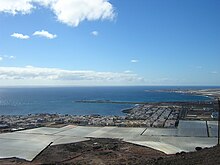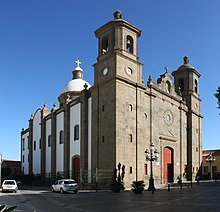Agüimes
Agüimes is a Spanish town and municipality belonging to the island of Gran Canaria, in the province of Las Palmas, autonomous community of the Canary Islands. It is part of the Commonwealth of the Southeast of Gran Canaria.
Toponymy
The municipality takes its name from its municipal head, which in turn is a voice of aboriginal origin.
It also appears in historical documentation with the variants Agüimez and Aguymes.
Regarding its possible meaning, Professor Juan Álvarez Delgado proposes its relationship with the aboriginal voices Güime from Lanzarote and Güímar from Tenerife. For said author, the translation of these terms from the Tuareg verb egmed, 'jump', 'launch', 'protrude', & #39;be magnified'.
The philologist Ignacio Reyes proposes the translation of Agüimes as 'embeleso, encanto, enchantment', and by extension 'santidad' or 'place of special virtue', from a primitive form agūmăs.
Symbols
Agüimes has an official municipal heraldic shield, flag and banner.
- Shield
The heraldic shield was approved by Decree of March 22, 1957, its description being:
Shield cut. First, of silver, a gull bar, highlighted of a castle in its color loaded with a siple tree and a dog tied to the trunk, of sable; second of gold, a luminous beam of silver out of the right hand, highlighted of a nao in its color set on waves of sugar and highlighted in turn of a palm of siple, loaded with an ancient crown of gold and accompanied by two panels of gold. To the bell, open royal crown loaded with a letter "G" of saber. The shield, surrounded by an episcopal cord. Like exterior ornaments, two branches of palm. Under the tip, silver ribbon with the legend Episcopal House of the Villa of Agüimes in letters of sable.
- Flag
The municipal flag was approved by the City Council on January 28, 2002, consisting of "light blue cloth, with a yellow ear of wheat in the center".
- Cotton
The banner was also approved in the same plenary session, being square, light blue in color and with the shield in the center.
Physical geography
Location
Agüimes is located in the southeast of the island of Gran Canaria, 28.5 km (kilometres) from the island capital. It borders the municipalities of Ingenio and Santa Lucía de Tirajana.
With a surface area of 79.28 km² (square kilometres), the municipality ranks 7th in size on the island.
Regarding the altitude of the municipality, the urban area of Agüimes is located at 270 m a.s.l. no. m. (meters above sea level). The maximum altitude of the term is located at 1673 m s. no. m. at a point in the Agua del Orián ravine.
Climate
The municipality of Agüimes has a warm arid dry climate, according to the Köppen classification.
The warmest month is August, with an average temperature of 23 °C, the coldest being January, with 16 °C. The average annual temperature is 19.3 °C.
Regarding rainfall, the municipality registers an average of 184 mm (millimeters) per year, with December being the rainiest month with 40 mm, and August the driest, when rainfall is nil.
Protected areas
The municipality has an area included in the Canary Islands Network of Protected Natural Spaces, fully including in its term the protected landscape of Montaña de Agüimes and the natural monument of Arinaga. In addition, it shares with the neighboring municipalities the natural monuments of Barranco de Guayadeque and Roque de Aguayro, as well as the special nature reserve of Los Marteles.
The area of the Los Marteles reserve, as well as the monuments of Guayadeque and Arinaga, are also included in the Natura 2000 Network as Special Conservation Areas —ZEC—, to which is added a maritime strip between the tip de la Sal to the north and the Arinaga port breakwater to the south, and the coastal area between the La Cerca mountain and the Arinaga mountain, including Vargas beach.
History
The territory of Agüimense is home to various pre-Hispanic settlements of great importance: the historic center of Agüimes, Guayadeque or Temisas.
Modern Agüimes was founded in 1491 on an important aboriginal settlement after the end of the Castilian conquest of Gran Canaria. It was created as a town under episcopal lordship by order of the Catholic Monarchs, and granted to the Church as compensation for its collaboration during the conquest. The uprising (riot) of the town of Agüimes on November 3, 1718 received the support of King Felipe V himself, granting them new lands and founding the municipalities of Santa Lucía de Tirajana, Vecindario, Ingenio and San Bartolomé de Tirajana and Arguineguín.
Its hydric wealth, thanks to the water courses coming from the basin of the Guayadeque ravine, allowed the first sugarcane crops after the conquest. More modern are the tomato and cucumber farms in the Arinaga area for export.
As in the rest of the southeast of Gran Canaria, part of the population of Agüimes opted in the past for emigration to Cuba, Puerto Rico and other countries in America. It is currently an immigration area, benefiting from the boom in tourism in the south of the island and other service activities. We must also point out the strength of the industrial area of Arinaga, around the port of the same name.
Demographics
In 2019, the municipality had 31,619 inhabitants and a population density of 398.82 inhabitants/km² (inhabitants per square kilometer).
It ranks 8th in population in the province of Las Palmas and 6th in the island of Gran Canaria.
| Graphic of demographic evolution of Agüimes between 1900 and 2021 |
 |
Official regular residents according to ISTAC population censuses. |
| Entity | Inhabitants | Male | Women |
|---|---|---|---|
| Agüimes (municipal capital) | 5547 | 2797 | 2750 |
| The Band | 560 | 291 | 269 |
| The Corralillos | 247 | 134 | 113 |
| Arinaga Cruise | 10454 | 5205 | 5249 |
| Quartet The One | 15 | 9 | 6 |
| The Goleta | 575 | 298 | 277 |
| Mountain Los Vélez | 1663 | 840 | 823 |
| San Francisco Mountain | 93 | 47 | 46 |
| Playa de Arinaga | 10035 | 5085 | 4950 |
| Polygon of Arinaga | 1239 | 642 | 598 |
| The Roses | 574 | 303 | 271 |
| Temisas | 298 | 161 | 137 |
| Vargas | 319 | 172 | 147 |
Politics
Municipal Corporation
The Agüimes City Council is made up of the mayor-president and twenty councilors. The 2019 municipal elections resulted in the following political composition of the city council:
- Roque Aguayro (RA): 16 councillors (absolute majority)
 Spanish Socialist Workers Party (PSOE): 3 councillors
Spanish Socialist Workers Party (PSOE): 3 councillors Citizens (Cs): 1 councillor
Citizens (Cs): 1 councillor Canary-United Coalition for Gran Canaria (CCa-UxGC): 1 councillor
Canary-United Coalition for Gran Canaria (CCa-UxGC): 1 councillor
City Hall
The municipality has been governed by the following mayors since the first democratic elections in 1979:
| Mayor. | Start of mandate | End of mandate | Party |
|---|---|---|---|
| Antonio Muñiz González | 1979 | 1983 | Roque Aguayro |
| José Armas Rodríguez | 1983 | 1987 | Roque Aguayro |
| Antonio Morales Méndez | 1987 | 2015 | Roque Aguayro |
| Óscar Hernández Suárez | 2015 | Position | Roque Aguayro |
Territorial organization
Agüimes is divided into the following singular entities or localities and their corresponding nuclei:
- Agüimes: Agüimes (casco) and Cueva Bermeja.
- The Band: The Band and White Plain.
- The Corralillos.
- Arinaga Cruise: The Head, Arinaga Cross, Pie de la Cuesta y Polígono Industrial de Arinaga.
- Quartet The One.
- The Goleta.
- San Francisco Mountain.
- Mountain Los Vélez: Mountain Los Vélez and Las Palmillas.
- Playa de Arinaga: Playa de Arinaga and Playa del Cabrón.
- Polygon of Arinaga: The Espinales, Residential Polygon of Arinaga and Industrial Polygon of Arinaga.
- The Roses: La Laguna, Las Rosas and Rosas Viejas.
- Temisas.
- Vargas: Vargas, Eden and El Oasis.
Economy
- Primary sector
Agüimes maintains agricultural activity with greenhouse farms in its coastal area, where tomatoes and ornamental plants are produced above all. In the towns of Temisas and Los Corralillos there are many small family farms dedicated mainly to the cultivation of potatoes, citrus fruits, subtropical fruit trees, olive trees and vineyards.
It also has abundant small livestock farms, mainly with goats, cattle and pigs.
- Secondary sector
The municipality has the Arinaga industrial estate and the Espinales industrial area, where more than seven hundred companies are located.
- Tertiary sector
As for the services sector, apart from small businesses and restaurants, Agüimes has a conventional hotel located in the old town hall in the center of the town, and a rural one in what used to be a camel stable. Likewise, it has several houses dedicated to rural tourism distributed both in the urban area and in the Temisas neighborhood.
Transportation
Connections
- Roads
The municipality is mainly connected by the Autopista del Sur GC-1 highway and by the GC-191 and GC-100 highways.
- Maritime transport
On the coast of the municipality is the port of Arinaga, intended to serve the industries of the annexed area.
Heritage
In the municipal term there are several valuable heritage elements:
- Archaeological
- Cave barn Many
- Caves of Morros de Ávila (BIC)
- Rupestres engravings of the Balos ravine (BIC)
- Guayadeque (BIC) ravine sites
- Caves and barns of La Audiencia (BIC)
- Caves of the Giant
- Caves and "concher" of Arinaga Mountain
- Religious
- Church of San Sebastian (BIC)
- Church of Saint Michael of Temisas
- Bermeja Cave Chapel
- Civil
- Historic helmet of the village of Agüimes (BIC)
- Temisas district (BIC)
- Arinaga lime furnaces
- Salinas de Arinaga
- Faro de Punta de Arinaga
- Natural
- Barranco de Guayadeque
- Mountain of Arinaga
- Agüimes Mountain
- Roque Aguayro
- Playa de Vargas
- Playa del Cabrón
Museums
The town has the privately owned Canarian Meteorite Museum.
Intangible cultural heritage
Festivities and traditions
In the municipality various festivals are celebrated, being local holidays the Monday after the festival of San Sebastián, and March 7, Carnival Thursday.
The main festivities that take place in Agüimes are those dedicated to the patron saint of the town, San Sebastián, and to its compatron, the Virgen del Rosario. The first ones take place in January, while the second ones take place between September and October.
The festivities of Ntra. Sra. del Rosario are declared of National Tourist Interest, and in them the popular acts of the Traída del Agua and Gofio stand out, which recall the old custom of taking the water mill located in the ravine from Guayadeque the cereal to grind it. A pilgrimage is also carried out.
Other festivities in the town are those held in honor of Saint José the Worker in Cruce de Arinaga between April and May, where homage is paid to the world of herding and sharecropping.
In Playa de Arinaga, festivities are held in honor of the Virgen del Pino between August and September, highlighting the so-called “Vará del pescao”, during which a simulation of the arrival of the fishermen at the port, where the neighbors wait and the sardines brought are roasted to the sound of music.
In the center of Cueva Bermeja, in the Guayadeque ravine, the festivities of San Bartolomé are celebrated, with the realization of the Beñesmén, during which a representation of aboriginal cults is carried out.
Featured Characters
Contenido relacionado
Pineira (Ribadeo)
Population of the Netherlands Antilles
Aldeatejada



